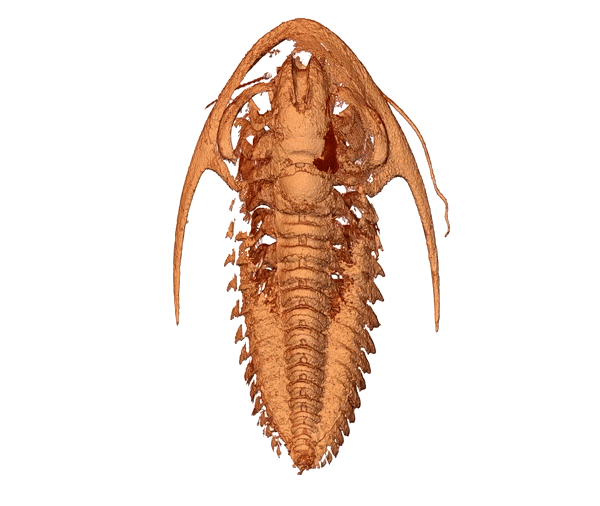Volcanic Ash Preserved Trilobite Fossils in Surprising Detail at ‘Prehistoric Pompeii’
The specimens date to more than 500 million years ago and provide new insights into trilobite anatomy, revealing previously unseen features
:focal(350x350:351x351)/https://tf-cmsv2-smithsonianmag-media.s3.amazonaws.com/filer_public/3b/d8/3bd8a090-c6cb-4f86-9820-d4fab0c6ba7a/trilobite.jpg)
Scientists have uncovered intricately preserved fossils of trilobites that are providing new insights into the extinct invertebrates’ anatomy.
The animals had been buried in modern-day Morocco after volcanic ash blanketed them underwater more than 500 million years ago. This preservation created 3D fossils that revealed several new features of trilobites, researchers reported Thursday in the journal Science.
“My jaw fell onto the desk,” John Paterson, a co-author of the study and paleontologist at the University of New England in Australia, tells New Scientist’s James Woodford. “I have never seen the level of detail preserved in these fossil trilobites. They are absolutely, no question, the best-preserved trilobites ever found.”
“The clarity of the preservation is astonishing and is of fundamental importance,” Nigel Hughes, a paleontologist at the University of California, Riverside, who did not contribute to the findings, says to Science News’ Lucas Van Wyk Joel. It “unequivocally confirms a number of conjectures made based on less well-preserved material, which demonstrates the power and importance of exceptional preservation.”
/https://tf-cmsv2-smithsonianmag-media.s3.amazonaws.com/filer_public/fd/cf/fdcf54ac-7363-4143-bcc3-dc329361793b/trilobite_fossil-article.jpg)
Trilobites were prehistoric marine invertebrates with distinctive exoskeletons on their backs that lived in sediment, on the sea floor or in open water. They appeared 520 million years ago and persisted for some 300 million years—around 1,000 times longer than Homo sapiens have lived so far—until they disappeared during the Permian mass extinction that wiped out roughly 90 percent of life on Earth.
Paleontologists have discovered more than 20,000 species of trilobites. But the vast majority of these fossils have preserved only their hard, outer skeletons—and scientists still don’t know very much about the animals’ softer interiors, per the study.
But the Moroccan volcano eruption, described in a statement as “prehistoric Pompeii,” created unusually detailed fossils. The trilobites died quickly under the ash and were rapidly preserved when the volcanic eruption trapped them underwater.
The water cooled the ash before it hit the trilobites, allowing it to encase the invertebrates instead of burning them, Robert Gaines, a co-author of the study and geologist at Pomona College, tells Science News.
“Volcanic ash is so fine grained, like talcum powder, that it can mold the tiniest anatomical features on the surface of these animals,” Paterson says to the New York Times’ Jack Tamisiea.

The team used computer modeling of X-ray slices of the fossils to study the trilobites’ anatomy in 3D. They found spines on the insides of the animals’ appendages that would have allowed them to tear up their prey as they moved the food toward their mouths. In one of the specimens, the digestive tract is also incredibly well-preserved, suggesting it ingested ash before it died.
From the detailed fossils, researchers also got a clear view of appendages around the mouth, including a fleshy lobe in front of the mouth called a labrum, which helps process food.
“The labrum has long been hypothesized to exist in trilobites, but never observed in fossils,” Paterson tells the New York Times.
Beyond providing new insights into trilobites’ structure, the study also demonstrates that volcanic ash deposited in water can be a promising place to look for fossils.
“I think pyroclastic deposits should become new targets for study, given their exceptional potential for trapping and preserving biological remains, including delicate soft tissues,” Abderrazak El Albani, a co-author of the study and a geologist at the University of Poitiers in France, says to BBC Wildlife Magazine’s Daniel Graham.
/https://tf-cmsv2-smithsonianmag-media.s3.amazonaws.com/accounts/headshot/Will-Sullivan-photo.png)
/https://tf-cmsv2-smithsonianmag-media.s3.amazonaws.com/accounts/headshot/Will-Sullivan-photo.png)

